Amid disillusionment with mainstream clubbing, illegal events are harking back to the original spirit of rave – but police maintain they are as dangerous and criminal as ever
Wil Crisp Wed 5 Feb 2020
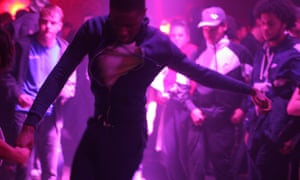
Dancers at a squat party in London’s King’s Cross,
October 2019. Photograph: Wil Crisp
t’s an hour after midnight on New Year’s Day 2020, and a stream of revellers is gathering in an alleyway next to KFC on London’s Old Kent Road. They pass between piles of car tyres and through a gap in a gate where a group, wrapped in hats and scarves, are taking £5 notes from each person who enters the yard of a recently abandoned Carpetright warehouse.
Inside, the lights are on and groups of partygoers are huddled in groups talking, waiting and smoking as a behemoth sound system and makeshift bar are constructed against one wall. Next door, in a larger abandoned warehouse that was formerly an Office Outlet, an even bigger sound system is being built.
There’s a sense of anticipation as the warehouse fills up with mohawked punks, tracksuited squatters, crusties, rude boys, accountants, graphic designers, students, and grey-haired veteran techno heads. Everyone has come together looking for the same thing: a night of loud electronic music and dancing without the constraints of a regulated night club. No closing time, no dress code, no age limit, no searches on the door.
In recent years, unlicensed underground raves like these, which are run by decentralised networks of soundsystems and party crews, have flourished across the UK as legitimate night clubs have foundered in the face of tighter licensing requirements and a population of young people with less disposable income.
In September, the drum’n’bass producer Goldie, who was awarded an MBE for his services to music in 2016, singled out illegal parties such as these as a key pillar of the UK dance music scene amid struggling clubs and increasingly corporate festivals. “Culture ain’t a thing you can put in a weekend festival,” he said. “Rave culture is thriving, but on an underground level. People want to go to fucking raves, people want to go to illegal parties.”
GOLDIE(@MRGOLDIE)
I played an illegal rave in a forest last night in Blackburn those kids are brilliant,there love for the music is pure! #dropjaw 🔥⚡️🙏🏼August 26, 2018
Bryan Gee, another British hall-of-fame drum’n’bass DJ, started playing reggae at south London squat parties in the early 80s, when he was 16. Today, he is in his 50s and still plays occasionally at unlicensed raves despite regularly DJing for crowds of over 7,000 at legitimate commercial venues. “I’ve turned up to unlicensed parties over the last couple of years and been shocked by the numbers,” he says. “Some club nights spend a ton of money on advertising and can’t pull in anything like the numbers these events get.”
“Since the 80s the illegal rave scene has always been active on some level,” says John (not his real name), a member of a prolific London-based free party crew. “It’s no coincidence that the original boom in acid house free parties took place after a decade of Tory government headed by Margaret Thatcher. It’s still here now and the current political climate is one reason why it’s healthier than it’s been for a long time.”
The last couple of years have seen scores of unlicensed events across the country, from 5,000-strong mega-raves in Bristol warehouses, to three-day breakcore soundclashes on south coast beaches, to intimate psytrance parties in the woodlands of Lancashire, and multi-rig “teknivals” on Scottish wind farms. Like John, many of those involved in the free party scene believe that these events are becoming more important than ever amid the widening social divides, ongoing Tory austerity and creeping gentrification.
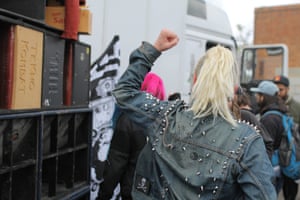
A London multi-rig party in November 2019,
attended by over 2,000 people. Photograph: Wil Crisp
The free party veteran and acid techno innovator Chris Liberator says that unlicensed raves are a way for people to take back control of their local areas, even if it is only for one night. “We are culturally in a place where normal people can’t control their environment at all,” he says. “I’ve seen the best pubs in my area turned into Starbucks – homogenous, big corporate high streets all with the same shops. There’s no space for people to live – let alone to throw events and have some fun on their own terms. There is very little cultural representation for anyone apart from the mainstream, and even the mainstream clubs are struggling to stay open.”
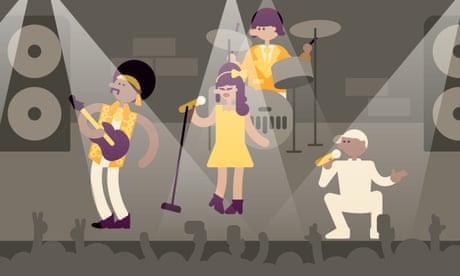
Police, though, maintain that these events pose “a significant risk to public order and public safety”, in the words of Metropolitan police service commander Dave Musker, who is the national lead for unlicensed music events. He describes them as “illegal, dangerous gatherings that encourage antisocial behaviour and are linked with serious criminal activity” and adds that organisers are changing the “structure” of their parties to “counter police tactics” (understandably, he refuses to detail these tactics on either side).
By 3am, hundreds of people have filled the dimly-lit warehouse. The giant sound system is thundering out a gut-shuddering set of bass-heavy jungle, and the walls are covered in an increasingly dense patchwork of graffiti tags. A heaving mass of ravers are thrashing and embracing on the thickly carpeted dancefloor in front of the speaker stacks. Around them are signs that say “20% off 1000s of carpets”.
People are risking arrest to create a space where people can come together, no matter who they are, in a country where social divides are increasingSophie Duniam
In a era of austerity, the unlicensed rave scene offers people a low-priced alternative to legal clubs. But that’s not the main reason people attend, according to Sophie Duniam, one half of underground electronic music duo My Bad Sister, which started out MCing at illegal events. “It offers people a place where they can come together as a community without prejudice and without intimidation,” she says. “People are risking arrest just to create a space where people can come together, no matter who they are, in a country where social divides are increasing. What the Tory government, and all governments, want to do is to isolate people so they can control them. When communities are united they are stronger and they can’t be pushed around.”
Duniam says that the ability of clubs and festivals to provide a similar space for free expression has been curtailed in recent years due to more stringent attitudes towards licence requirements. Drug-related incidents have led to the closure of several clubs in recent years, including The Arches, which used to be located in Glasgow and had its nightclub licence revoked in 2015, after the death of an underage clubber. In 2016, London superclub Fabric also saw its licence taken away for five months, following the death of two 18-year-olds after taking drugs on the premises. It reopened in 2017 with stricter security regulations. “It’s like 1920s prohibition in America,” Duniam says of the legal clubbing scene. “When we perform at Fabric all of the punters are searched and have their passports photocopied before they are allowed into the club – and you can get chucked out for having a vape.”
Many believe the rave scene is filling a void left after a decline in grassroots venues, defined by the mayor of London’s office as those that focus mainly on music, and play an important role in local communities or as a hub for musicians. In July, figures revealed there were only 100 grassroots music venues in the capital, 30% fewer than in 2007. It’s representative of a nationwide decline: a government select committee report published in 2019 warned that the “closure of music venues presents a significant and urgent challenge to the UK’s music industry and cultural vibrancy”.
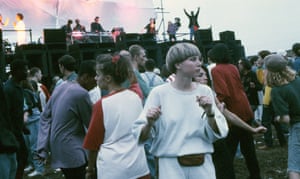
Original nuttahs ... a rave in Ashworth valley,
Rochdale, 5 August 1989. Photograph:
Peter J Walsh/Pymca/Rex/Shutterstock
The Bristol-based DJ, producer and record label owner Mandidextrous, who started her career DJing at free parties in the early 2000s in Buckinghamshire, says “the innovation that happens in the underground is what fuels the commercial scene”. She also believes that the UK’s squat party scene offers a unique space for people to come together. “As a transgender woman, I’ve been two different people in the rave scene, and I have been openly welcomed throughout the whole thing. You get every single walk of life.”
It’s 10am on the Old Kent Road, New Year’s Day. A flood of new people enter the former Office Outlet warehouse from another unlicensed event, which took place in an office block on the South Bank and was shut down after police seized the sound system in the early hours. As the pale morning light streams through the skylights, hundreds of ravers are dancing to a hardtek remix of DJ Nehpets’ Bounce, Ride. A man with a wild head of grey hair is cutting intricate lines through the peripheries of a crowd of a pair of roller skates, swooping inches away from a teenager asleep on the floor wrapped up in a large yellow “Store Closing” sign.
Since the original boom in acid house parties in the late 80s, the unlicensed rave scene has been the target of media scare stories about drug overdoses and violence, but many of those who regularly attend say they feel safer than when they attend legal club nights. “Parties take place without a problem every weekend,” says Duniam, comparing them with licensed events where “people are kicked out at four in the morning, or earlier if they have done something to piss off the security. If you are a teenage girl and you haven’t got money for a cab, and the trains don’t start running until six or seven in the morning, being thrown out can leave you in a very vulnerable position. This would never happen at most illegal raves where, because no one is getting paid to look after anyone, everyone is looking out for each other as a community.”
The police claim this utopian vision is false. In 2017, two people were shot when gunmen wearing masks let off semi-automatic weapons at an illegal party in Leyton, and over the course of 2014 two teenage boys died after taking drugs at separate unlicensed raves in London. The Met’s Dave Musker says: “The obvious public risk comes from unsafe derelict buildings, overcrowding and youths being exposed to alcohol and illegal drugs in an environment which encourages excess. The revellers at these events are often unlikely to report crimes, including serious sexual assault, due to the culture of taking part in an illegal activity. Young people under the influence of alcohol or drugs are also at risk of being victims of crime or violence as they leave the venue.” He maintains the police’s priority is “to protect vulnerable people”.
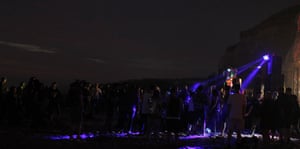
A beach rave on the south coast in August 2019.
Photograph: Wil Crisp
This is all a gross misrepresentation, according to Mandidextrous. “I’ve been attending illegal raves for more than 20 years, attending hundreds of illegal parties, and I have hardly seen any violence,” she says. “Any I have seen has actually come from the presence of police. If you go down any high street on a Saturday night you see bar brawls and fights on the streets; if you go to a rave, no one is fighting. Everyone is there to have a good time. Occasionally you get a few bad people – but nine times out of 10 they are marched out of the rave as soon as they do something wrong.”
The rave in Carpetright at least passes off without incident: by 9pm, the last of the equipment is being packed into vans while a handful of remaining partygoers sit around a small fire in the yard of the warehouse. Some are discussing the Tory campaign pledge to change the law on trespass and give police new powers to arrest and seize the property and vehicles of those “who set up unauthorised encampments”. The plans have been seen as an attempt to criminalise Gypsies and Travellers, and could also have ramifications for the free party scene. “Even if the laws get changed raves will carry on in some form,” says one person. “There are too many crews and too many sound systems.” As if to illustrate their point, another white van pulls up, and another crew get out to clean up the venue ahead of their own party the following weekend.
---30---
No comments:
Post a Comment